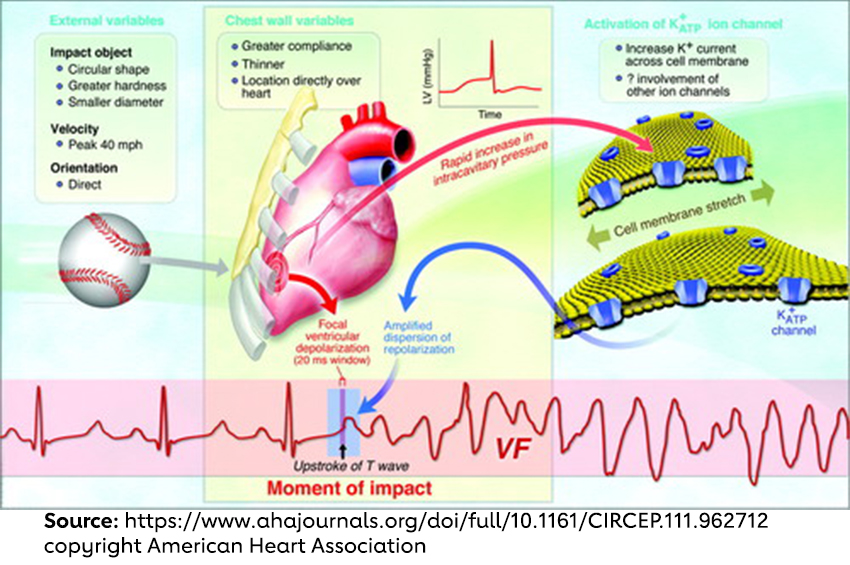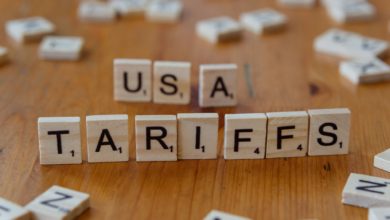Commotio cordis is extremely rare; quick action essential: call 911, begin CPR and use AED
[ad_1]
Key information:
- Commotio cordis (kə-ˈmō-shē-ō-ˈkȯrd-əs) is an extremely rare consequence of blunt force trauma to the heart that happens at exactly the wrong time in the heart rhythm, causing the heart to stop beating effectively. Collapse occurs within a few seconds.
- The impact occurs over the left chest wall, and it is generally sustained with a hard spherical object, such as a baseball, hockey puck, lacrosse ball or softball.
- There are no risk factors for commotio cordis. It is an extremely rare event that may affect anyone playing a physical contact sport.
- Commotio cordis occurs mostly in boys and young men (average age of 15), usually during sports, often despite wearing a chest protector.
- Quick recognition of the cardiac emergency and immediately beginning the 3 most important steps in the chain of survival are critical: 1) call 911, 2) begin CPR and 3) defibrillate with an automated external defibrillator or AED. These are the only ways to save someone’s life after commotio cordis or cardiac arrest.
 (NewMediaWire) – April 18, 2023 – DALLAS — Commotio cordis (kə-ˈmō-shē-ō-ˈkȯrd-əs) is an extremely rare and highly unusual cardiac event, yet it is vitally important for everyone to be aware of and recognize how to take action quickly in any type of cardiac emergency. According to the American Heart Association, quick recognition of the cardiac emergency and immediately beginning the 3 most important steps in the chain of survival are critical: 1) call 911, 2) begin CPR and 3) defibrillate with an automated external defibrillator or AED. These are the only ways to save someone’s life after commotio cordis or cardiac arrest. The American Heart Association is the leader in resuscitation science, education and training and publisher of the official “Guidelines for CPR and Emergency Cardiovascular Care“.
(NewMediaWire) – April 18, 2023 – DALLAS — Commotio cordis (kə-ˈmō-shē-ō-ˈkȯrd-əs) is an extremely rare and highly unusual cardiac event, yet it is vitally important for everyone to be aware of and recognize how to take action quickly in any type of cardiac emergency. According to the American Heart Association, quick recognition of the cardiac emergency and immediately beginning the 3 most important steps in the chain of survival are critical: 1) call 911, 2) begin CPR and 3) defibrillate with an automated external defibrillator or AED. These are the only ways to save someone’s life after commotio cordis or cardiac arrest. The American Heart Association is the leader in resuscitation science, education and training and publisher of the official “Guidelines for CPR and Emergency Cardiovascular Care“.
“Commotio cordis is an extremely rare consequence of blunt force trauma to the chest of the proper type and intensity at exactly the wrong time in the heartbeat. These are several extraordinary things that must all happen at exactly the same, wrong time in a 20-40 millisecond window of the second half of a heartbeat, when the lower chambers of the heart are preparing to contract,” said Gordon F. Tomaselli, M.D., FAHA, a past volunteer president of the American Heart Association (2011-2012) and the Marilyn and Stanley M. Katz Dean at Albert Einstein College of Medicine in the Bronx, New York. “Collapse occurs within seconds. Quick recognition of the cardiac emergency and immediately beginning the 3 most important steps in the chain of survival: 1) call 911, 2) begin CPR and 3) defibrillate with an automated external defibrillator or AED. These steps are essential for survival and optimal recovery.”
Dr. Tomaselli is an internationally renowned physician-scientist in the field of cardiovascular disease and a cardiac electrophysiologist who specializes in sudden cardiac death and heart rhythm disturbances. His research on the regulation of the hearts’ electrical activity has led to breakthrough therapies that prevent fatal heart disorders.
The blunt force impact is generally sustained with a hard spherical object such as a baseball, hockey puck, lacrosse ball or softball and may affect anyone playing a physical contact sport. Commotio cordis occurs mostly in boys and young men (average age of 15), usually during sports, often despite wearing a chest protector.
Commotio cordis is a specific type of cardiac arrest that may affect anyone playing a physical contact sport. A recent review of the National Commotio Cordis Registry has found that commotio cordis may also occur from blunt force trauma to the chest in non-sports activities, such as an assault, car accident or daily activities. Of the 334 cases of commotio cordis identified from 1980-2022, 121 (36%) occurred in non-sport-related activities and 213 (64%) occurred in a sport-related activity.
Each day, the human heart may beat anywhere from 86,400 to 144,000 times (assuming an average of 60-100 beats per minute over a 24-hour period), and each heartbeat is an average of 0.8 seconds long. For commotio cordis to occur, the heart must be struck with blunt force during a specific 20-40 millisecond window of one heartbeat, as the lower chambers of the heart are about to contract, producing a life-threatening disturbance of the heart rhythm. An electrical shock to the heart from an AED is necessary to jolt the heart back into normal rhythm.
With prompt CPR and defibrillation, the survival and recovery rates after a commotio cordis episode are greater than 50%.
“If there’s one lesson that we can all learn, it’s that the best way to help anyone survive a cardiac emergency including commotio cordis is for as many of us as possible to learn CPR. And for each of us to be ready and able to respond to a cardiac emergency that can occur literally anywhere. Immediately beginning the steps in the chain of survival – calling 911, prompt CPR and defibrillation – these are essential to saving someone’s life, and they must begin within the seconds and minutes after the individual collapses,” added Tomaselli. “Commotio cordis is an extremely rare event, but if it occurs during a sports event with ready access to trained emergency care personnel and AEDs, and CPR and defibrillation begin promptly, the survival rate is now quite good, in excess of 50%, which is a vast improvement to the less than 10% survival rate for most out-of-hospital cardiac arrests. And, in most cases, the individual affected is able to resume their previous life and activities.”
“We must focus on those first few minutes after commotio cordis or sudden cardiac arrest from any cause because these are the most critical — every minute without the heart beating and the lungs not getting oxygen equates to a potential 10% loss of function and 10% lower odds of survival. We have 10 minutes to save a life,” concluded Tomaselli.
“We are pleased that it appears Damar Hamlin will make a full recovery,” said Nancy Brown, chief executive officer of the American Heart Association. “If there is some greater good that can come from his commotio cordis event, it is that as many people as possible are now aware of how important it is to provide urgent care for all cardiac emergencies — everyone watching that night saw the chain of survival in action, successfully performed. Calling 911, and prompt CPR and defibrillation are essential to saving someone’s life and optimal recovery. We strongly urge that at least one person in every household learn CPR and be ready to take action as soon as they witness someone having a cardiac emergency.”
According to the American Heart Association’s 2023 Statistical Update, more than 350,000 people in the U.S. experience sudden cardiac arrest outside of a hospital. About 90 percent of people who suffer out-of-hospital cardiac arrests die, meaning only about 1 in 10 survive. As many as 23,000 people under the age of 18 experience out-of-hospital sudden cardiac arrest annually. It is the leading cause of death for student athletes and sports-related sudden cardiac arrest accounts for nearly 40% of sudden cardiac arrests among people under the age of 18.
Roughly 70% of cardiac arrests occur in homes and private residences not in hospitals (out-of-hospital cardiac arrest.), therefore, a friend or family member is mostly likely to be the person who needs to take action. CPR, especially if performed immediately, may double or triple a cardiac arrest victim’s chance of survival.
The Association has long advocated for public policies at the federal, state and community levels that encourage the development of cardiac emergency response plans, increase CPR and AED education and training, and strengthen systems of care. Last month, the Association joined with the National Football League to announce the launch of The Smart Heart Sports Coalition with the NFL, NBA, MLB, MLS, NHL, NCAA, the American Red Cross, Korey Stringer Institute, National Athletic Trainers’ Association and Damar Hamlin’s Chasing M’s Foundation. These and other public policies can prevent deaths from sudden cardiac arrest and should be implemented nationwide.
Resources for learning CPR and information about AEDs
For adults and adolescent children, Hands-Only CPR is an easy-to-learn skill that requires only two steps: call 911, and push hard and fast in the center of the chest at a rate of 100-120 beats per minute. You can find a CPR class near you at heart.org/findacourse. For more information about CPR, visit cpr.heart.org.
AEDs are lifesaving devices, and most AEDs prompt the user with verbal instructions for each of the steps on how to use the device. More information about the use of AEDs and training are available here.
The Association receives funding primarily from individuals. Foundations and corporations (including pharmaceutical, device manufacturers and other companies) also make donations and fund specific Association programs and events. The Association has strict policies to prevent these relationships from influencing the science content. Revenues from pharmaceutical and biotech companies, device manufacturers and health insurance providers, and the Association’s overall financial information are available here.
Additional Resources:
- VIDEO (expert interview clips) and Infographics on commotio cordis and the Chain of Survival are available on the right column of release link.
- AHA health information: About commotio cordis
- AHA news releases:
- Follow AHA/ASA news on Twitter @HeartNews
About the American Heart Association
The American Heart Association is a relentless force for a world of longer, healthier lives. We are dedicated to ensuring equitable health in all communities. Through collaboration with numerous organizations, and powered by millions of volunteers, we fund innovative research, advocate for the public’s health and share lifesaving resources. The Dallas-based organization has been a leading source of health information for nearly a century. Connect with us on heart.org, Facebook, Twitter or by calling 1-800-AHA-USA1.
###
For Media Inquiries: 214-706-1173
Michelle Kirkwood: 703-457-7838; michelle.kirkwood@heart.org
For Public Inquiries: 1-800-AHA-USA1 (242-8721)
heart.org and stroke.org
[ad_2]




